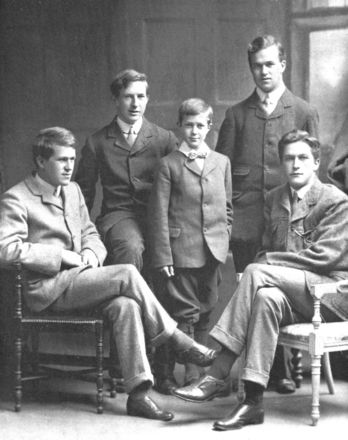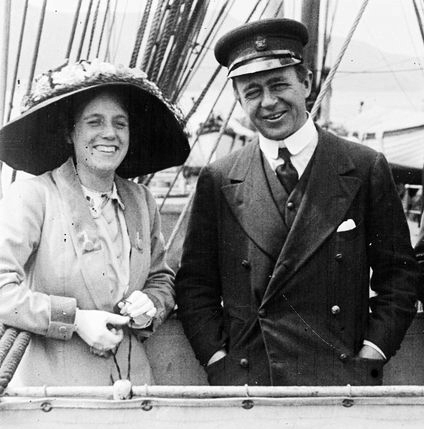|
A. W. Lawrence
Arnold Walter Lawrence (2 May 1900 – 31 March 1991) was a British authority on classical sculpture and architecture. He was Laurence Professor of Classical Archaeology at Cambridge University in the 1940s, and in the early 1950s in Accra he founded what later became the Ghana Museums and Monuments Board as well as the National Museum of Ghana. He was the youngest brother of T. E. Lawrence ("Lawrence of Arabia") and his literary executor. Early life Arnold Lawrence was born at 2 Polstead Road, Oxford, on 2 May 1900, the youngest of five sons born to Thomas Chapman (who became, in 1914, Sir Thomas Chapman, 7th Baronet), an Anglo-Irish nobleman from County Westmeath, and Sarah Junner (1861–1959). The couple were unmarried but took the names "Thomas Robert Lawrence" and "Sarah Lawrence". Their second son was T. E. Lawrence who later found fame as "Lawrence of Arabia". He and Arnold Lawrence were close. The Lawrence children were brought up in Oxford by their mother who wa ... [...More Info...] [...Related Items...] OR: [Wikipedia] [Google] [Baidu] |
Arnold W
Arnold may refer to: People * Arnold (given name), a masculine given name * Arnold (surname), a German and English surname Places Australia * Arnold, Victoria, a small town in the Australian state of Victoria Canada * Arnold, Nova Scotia United Kingdom * Arnold, East Riding of Yorkshire * Arnold, Nottinghamshire United States * Arnold, California, in Calaveras County * Arnold, Carroll County, Illinois * Arnold, Morgan County, Illinois * Arnold, Iowa * Arnold, Kansas * Arnold, Maryland * Arnold, Mendocino County, California * Arnold, Michigan * Arnold, Minnesota * Arnold, Missouri * Arnold, Nebraska * Arnold, Ohio * Arnold, Pennsylvania * Arnold, Texas * Arnold, Brooke County, West Virginia * Arnold, Lewis County, West Virginia * Arnold, Wisconsin * Arnold Arboretum of Harvard University, Massachusetts * Arnold Township, Custer County, Nebraska Other uses * Arnold (automobile), a short-lived English car * Arnold of Manchester, a former English coachbuilder * Arnold (band), ... [...More Info...] [...Related Items...] OR: [Wikipedia] [Google] [Baidu] |
Fellow
A fellow is a concept whose exact meaning depends on context. In learned or professional societies, it refers to a privileged member who is specially elected in recognition of their work and achievements. Within the context of higher educational institutions, a fellow can be a member of a highly ranked group of teachers at a particular college or university or a member of the governing body in some universities (such as the Fellows of Harvard College); it can also be a specially selected postgraduate student who has been appointed to a post (called a fellowship) granting a stipend, research facilities and other privileges for a fixed period (usually one year or more) in order to undertake some advanced study or research, often in return for teaching services. In the context of research and development-intensive large companies or corporations, the title "fellow" is sometimes given to a small number of senior scientists and engineers. In the context of medical education in No ... [...More Info...] [...Related Items...] OR: [Wikipedia] [Google] [Baidu] |
Alan Wace
Alan John Bayard Wace (13 July 1879 – 9 November 1957) was an English archaeologist. Biography Wace was educated at Shrewsbury School and Pembroke College, Cambridge. He was director of the British School at Athens (1914–1923), Deputy Keeper in the Department of Textiles in the Victoria and Albert Museum (1924–1934), the second Laurence Professor of Classical Archaeology at University of Cambridge (1934–1944) and professor at the Farouk I University in Egypt (1943–1952). Among Wace's field projects were those at Sparta, Mycenae, Troy, Thessaly, Corinth, and Alexandria. Along with Carl Blegen, Wace carried out important work on the decipherment of Linear B tablets. Elizabeth (Lisa) Bayard French, was Wace's daughter. Works *''Prehistoric Thessaly'' (1912). *''The nomads of the Balkans : an account of life and customs among the Vlachs of northern Pindus''(1913). *''Excavations at Mycenae'' (1923). *''Chamber tombs at Mycenae'' (1932). *''The Sarcophagus of Alexander ... [...More Info...] [...Related Items...] OR: [Wikipedia] [Google] [Baidu] |
University Of Cambridge
, mottoeng = Literal: From here, light and sacred draughts. Non literal: From this place, we gain enlightenment and precious knowledge. , established = , other_name = The Chancellor, Masters and Scholars of the University of Cambridge , type = Public research university , endowment = £7.121 billion (including colleges) , budget = £2.308 billion (excluding colleges) , chancellor = The Lord Sainsbury of Turville , vice_chancellor = Anthony Freeling , students = 24,450 (2020) , undergrad = 12,850 (2020) , postgrad = 11,600 (2020) , city = Cambridge , country = England , campus_type = , sporting_affiliations = The Sporting Blue , colours = Cambridge Blue , website = , logo = University of Cambridge logo ... [...More Info...] [...Related Items...] OR: [Wikipedia] [Google] [Baidu] |
Clouds Hill
Clouds Hill is an isolated cottage near Wareham in the county of Dorset in South West England. It is the former home of T. E. Lawrence ("Lawrence of Arabia") and is owned by the National Trust. The site is in the parish of Turners Puddle in Purbeck District. History The small building has colourwashed brick walls and a tiled roof. It was probably built as forester's cottage in the early 19th century. The lintel over the door bears a Greek inscription ''οὐ φροντὶς'' ("Why Worry"). It is now a Grade II* listed building as "Clouds Hill (Lawrence of Arabia's Cottage)"; it was upgraded from Grade II in 2015. Lawrence first rented the cottage in 1923 while stationed at nearby Bovington Camp with the Tank Corps. He made it habitable with the help of a friend, then bought it in 1925 and used it as a holiday home. He described it as an earthly paradise and wrote "Nothing in Clouds Hill is to be a care upon the world. While I have it there shall be nothing exquisite or ... [...More Info...] [...Related Items...] OR: [Wikipedia] [Google] [Baidu] |
Scott Polar Research Institute
The Scott Polar Research Institute (SPRI) is a centre for research into the polar regions and glaciology worldwide. It is a sub-department of the Department of Geography in the University of Cambridge, located on Lensfield Road in the south of Cambridge. SPRI was founded by Frank Debenham in 1920 as the national memorial to Captain Robert Falcon Scott and his companions, who died on their return journey from the South Pole in 1912. It investigates issues relevant to the Arctic and Antarctic in the environmental sciences, social sciences and humanities. The institute is home the Polar Museum and has some 60 personnel, consisting of academic, library and support staff plus postgraduate students, associates and fellows attached to research programmes. The institute also hosts the Scientific Committee on Antarctic Research. Research SPRI has several research groups. Notable researchers that have been based at the institute include Julian Dowdeswell, British diplomat Bryan Robert ... [...More Info...] [...Related Items...] OR: [Wikipedia] [Google] [Baidu] |
Kathleen Scott
Edith Agnes Kathleen Young, Baroness Kennet, Royal British Society of Sculptors, FRBS (née Bruce; formerly Scott; 27 March 1878 – 25 July 1947) was a British sculptor. Trained in London and Paris, Scott was a prolific sculptor, notably of portrait heads and busts and also of several larger public monuments. These included a number of war memorials plus statues of her first husband, the Antarctic explorer Captain Robert Falcon Scott. Although the ''Oxford Dictionary of National Biography'' describes her as "the most significant and prolific British women sculptor before Barbara Hepworth", her traditional style of sculpture and her hostility to the abstract work of, for example Jacob Epstein and Henry Moore, has led to a lack of recognition for her artistic achievements. Kathleen Scott was the mother of Sir Peter Scott, the painter and naturalist and of the writer and politician Wayland Young, 2nd Baron Kennet, Wayland Young from her second marriage to Hilton Young, 1st B ... [...More Info...] [...Related Items...] OR: [Wikipedia] [Google] [Baidu] |
The Times
''The Times'' is a British daily national newspaper based in London. It began in 1785 under the title ''The Daily Universal Register'', adopting its current name on 1 January 1788. ''The Times'' and its sister paper ''The Sunday Times'' (founded in 1821) are published by Times Newspapers, since 1981 a subsidiary of News UK, in turn wholly owned by News Corp. ''The Times'' and ''The Sunday Times'', which do not share editorial staff, were founded independently and have only had common ownership since 1966. In general, the political position of ''The Times'' is considered to be centre-right. ''The Times'' is the first newspaper to have borne that name, lending it to numerous other papers around the world, such as ''The Times of India'', ''The New York Times'', and more recently, digital-first publications such as TheTimesBlog.com (Since 2017). In countries where these other titles are popular, the newspaper is often referred to as , or as , although the newspaper is of nationa ... [...More Info...] [...Related Items...] OR: [Wikipedia] [Google] [Baidu] |
First World War
World War I (28 July 1914 11 November 1918), often abbreviated as WWI, was one of the deadliest global conflicts in history. Belligerents included much of Europe, the Russian Empire, the United States, and the Ottoman Empire, with fighting occurring throughout Europe, the Middle East, Africa, the Pacific, and parts of Asia. An estimated 9 million soldiers were killed in combat, plus another 23 million wounded, while 5 million civilians died as a result of military action, hunger, and disease. Millions more died in genocides within the Ottoman Empire and in the 1918 influenza pandemic, which was exacerbated by the movement of combatants during the war. Prior to 1914, the European great powers were divided between the Triple Entente (comprising France, Russia, and Britain) and the Triple Alliance (containing Germany, Austria-Hungary, and Italy). Tensions in the Balkans came to a head on 28 June 1914, following the assassination of Archduke Franz Ferdina ... [...More Info...] [...Related Items...] OR: [Wikipedia] [Google] [Baidu] |
Carchemish
Carchemish ( Turkish: ''Karkamış''; or ), also spelled Karkemish ( hit, ; Hieroglyphic Luwian: , /; Akkadian: ; Egyptian: ; Hebrew: ) was an important ancient capital in the northern part of the region of Syria. At times during its history the city was independent, but it was also part of the Mitanni, Hittite and Neo-Assyrian Empires. Today it is on the frontier between Turkey and Syria. It was the location of an important battle, about 605 BC, between the Babylonians and Egyptians, mentioned in the Bible (Jer. 46:2). Modern neighbouring cities are Karkamış in Turkey and Jarabulus in Syria (also Djerablus, Jerablus, Jarablos, Jarâblos); the original form of the modern toponym seems to have been Djerabis or Jerabis, likely derived from Europos, the ancient name of the Hellenistic-Roman settlement. Geography of the site Carchemish is now an extensive set of ruins (90 hectares, of which 55 lie in Turkey and 35 in Syria), located on the West bank of Euphrates Riv ... [...More Info...] [...Related Items...] OR: [Wikipedia] [Google] [Baidu] |




